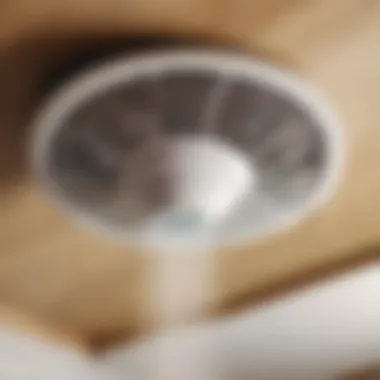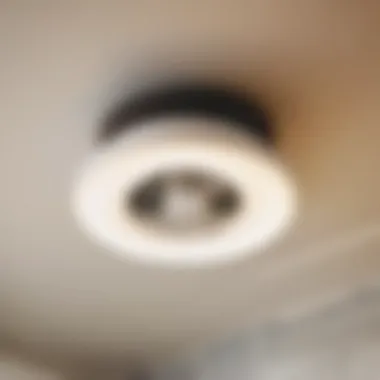Unveiling the Ultimate Guide to the Highest CFM Bathroom Fan Selection


Materials:
- Highest CFM bathroom fan
- Mounting brackets
- Ductwork
- Roof vent
- Electric drill
- Tape measure
- Screwdriver
- Safety glasses
- Gloves
DIY Steps:
- Planning: Measure the size of your bathroom to determine the appropriate CFM rating for the fan.
- Research: Explore various brands and models of high CFM bathroom fans to find the best fit for your needs.
- Purchase: Acquire all necessary materials listed above.
- Preparation: Clear the installation area in the ceiling and gather your tools.
- Installation: Follow the manufacturer's instructions to mount the fan, connect the ductwork, and secure the roof vent.
- Testing: Turn on the fan to ensure proper functioning and air circulation.
- Finishing Touches: Seal any gaps around the fan to optimize airflow.
Technical Aspects:
- Tools: Electric drill for securing brackets, screwdriver for fastening screws, tape measure for precise measurements.
- Timing: Allow a few hours for installation depending on experience level.
- Techniques: Ensure the fan is level during installation for optimal operation.
DIY Project Process:
- Mounting the Fan: Secure the mounting brackets to the ceiling joists using the electric drill.
- Connecting Ductwork: Attach the ductwork to the fan and route it outside through the roof vent.
- Securing Roof Vent: Install the roof vent over the ductwork opening and secure it in place.
Troubleshooting Tips:
- If the fan is making excessive noise, check for loose screws or improper installation.
- Insufficient airflow may indicate a blockage in the ductwork; ensure it is properly connected and unobstructed.
Enjoy a well-ventilated and moisture-controlled bathroom with the highest CFM fan, providing optimal air quality and comfort.
Introduction
Bathroom ventilation is a crucial aspect of maintaining a healthy and comfortable living environment. In this comprehensive guide on exploring the highest CFM bathroom fan, we delve into the intricacies of air circulation and moisture control. A well-ventilated bathroom not only helps in improving indoor air quality but also prevents the growth of mold and mildew while enhancing overall comfort. By understanding the significance of CFM ratings and selecting the right fan, homeowners can ensure optimal ventilation for their bathrooms.
Importance of Bathroom Ventilation
Impact on Indoor Air Quality
When it comes to indoor air quality, proper bathroom ventilation plays a vital role in eliminating pollutants and excess humidity. By efficiently removing odors and airborne contaminants, a high CFM bathroom fan can significantly enhance the air quality in your home. The ability to address these factors contributes to a healthier living space and reduces the risk of respiratory issues associated with poor air quality.
Prevention of Mold and Mildew
One of the primary benefits of a powerful bathroom fan is its ability to prevent the formation of mold and mildew. By expelling moist air from the bathroom effectively, the risk of moisture accumulation is reduced, thereby mitigating mold growth. This proactive approach not only safeguards the structural integrity of the bathroom but also promotes a hygienic environment for residents, ensuring long-term health benefits.
Enhancement of Comfort


In addition to health considerations, a well-ventilated bathroom also enhances overall comfort for occupants. By maintaining proper airflow and regulating humidity levels, a high CFM bathroom fan creates a more pleasant and enjoyable bathroom experience. Improved comfort levels lead to enhanced relaxation during showers or baths, offering a soothing environment for unwinding after a long day.
Significance of CFM Rating
Definition of CFM
CFM, or cubic feet per minute, is a measurement metric that indicates the volume of air a fan can exhaust in a minute. Understanding the definition of CFM is crucial in selecting the right bathroom fan with the appropriate airflow capacity. By matching the CFM rating to the size and usage frequency of the bathroom, homeowners can ensure efficient air circulation and moisture management. This fundamental concept forms the basis for evaluating the effectiveness of a bathroom fan in maintaining a healthy indoor environment.
Determining Proper CFM for a Bathroom Fan
The proper determination of CFM for a bathroom fan involves considering various factors such as bathroom size, layout, and ventilation requirements. Calculating the required CFM based on these parameters allows homeowners to choose a fan that suits their specific needs. By assessing the ventilation needs of the space and understanding how CFM impacts air quality, individuals can make informed decisions to optimize the performance of their bathroom fan for effective operation.
Factors Influencing CFM Needs
Bathroom ventilation is a crucial aspect to consider in any household, and factors influencing CFM needs play a significant role in ensuring optimal air quality and moisture control. When it comes to choosing the right bathroom fan, factors such as bathroom size, layout, humidity levels, and frequency of usage all come into play.
Bathroom Size and Layout
In determining the necessary CFM for your bathroom, calculating the CFM requirement based on size is a critical step. The size of the bathroom directly impacts the amount of air that needs to be circulated to maintain air quality and remove moisture effectively. Factors such as square footage, ceiling height, and the presence of other ventilation sources need to be considered when calculating the CFM requirement. This information helps in selecting a fan that can efficiently handle the specific needs of your bathroom.
When evaluating considerations for open vs. enclosed layouts, it's essential to understand how the layout of the bathroom can affect airflow and ventilation. Open layouts may have better air circulation naturally, while enclosed layouts might require a more powerful fan to ensure adequate airflow. By assessing the layout of your bathroom, you can make informed decisions about the type of fan that will best suit your space, ensuring optimal ventilation and moisture control.
Humidity Levels and Usage Frequency
High humidity levels can significantly impact the effectiveness of a bathroom fan. Areas with high humidity levels require a more powerful fan to combat excess moisture and prevent issues like mold and mildew growth. Understanding the impact of humidity on CFM needs allows homeowners to choose a fan that can adequately address the specific conditions in their bathroom environment.
The frequency of fan usage is another crucial factor to consider. Homes with high usage frequency, such as multiple showers a day, may benefit from a fan with higher CFM to ensure consistent ventilation. By evaluating how often the fan will be in operation, homeowners can select a fan that aligns with their usage patterns, promoting efficient ventilation and moisture control.
Duct Length and Ventilation Path
The duct length and ventilation path play essential roles in determining the overall performance of a bathroom fan. The length of the duct affects airflow efficiency, with longer ducts potentially reducing the fan's effectiveness. Properly optimized airflow efficiency ensures that the fan can effectively circulate air throughout the bathroom, aiding in moisture removal and maintaining air quality.
When considering the ventilation path, factors such as bends, turns, and obstacles along the duct route can obstruct airflow. Optimizing the ventilation path by minimizing bends and ensuring a clear, unobstructed route for airflow enhances the overall efficiency of the fan. By addressing these factors, homeowners can maximize the performance of their bathroom fan, promoting effective ventilation and moisture control in the space.
Types of Bathroom Fans
When delving into the realm of bathroom ventilation, understanding the intricacies of different types of bathroom fans becomes paramount. The choice of bathroom fan can significantly impact the air circulation and moisture control within a bathroom space, making it a key consideration for any household looking to enhance their indoor environment. By exploring the various types of bathroom fans available on the market, individuals can make more informed decisions based on their specific needs and preferences.
Ceiling-Mounted Fans


Pros and Cons
Ceiling-mounted fans are popular choices for many households due to their effectiveness in removing excess moisture and odors from the air. The key advantage of ceiling-mounted fans lies in their ability to efficiently circulate air throughout the entire bathroom, ensuring thorough ventilation. However, a potential drawback of these fans is the need for professional installation, which can be a consideration for those looking for a DIY-friendly option. Despite this, the seamless integration of ceiling-mounted fans into the bathroom ceiling can enhance the overall aesthetics and functionality of the space.
Installation Considerations
When considering the installation of a ceiling-mounted fan, factors such as the bathroom layout and existing ventilation infrastructure play a crucial role. It is essential to evaluate the ceiling space available for mounting the fan and ensure proper electrical connections for seamless operation. Additionally, positioning the fan in an optimal location to maximize air circulation and minimize noise disruption is key for achieving the desired ventilation outcomes. Installation considerations for ceiling-mounted fans also include selecting the appropriate fan size based on the bathroom dimensions and airflow requirements, ensuring efficient and effective performance.
Inline Fans
Suitability for Specific Settings
Inline fans offer a versatile solution for bathrooms with limited ceiling space or complex ducting requirements. Their compact design makes them suitable for installation in various settings, including bathrooms with restricted ceiling clearance or unconventional ventilation pathways. The key characteristic of inline fans is their ability to discreetly enhance airflow without compromising on ventilation efficiency. This makes them a popular choice for individuals seeking a practical and space-saving ventilation solution.
Enhanced Airflow Options
Incorporating enhanced airflow options, such as variable speed settings or airflow direction controls, inline fans provide flexibility in adjusting ventilation levels to suit changing indoor air conditions. These additional features allow users to customize the fan operation based on humidity levels, usage frequency, and specific ventilation requirements, enhancing overall air quality and comfort within the bathroom space. However, potential disadvantages of inline fans may include the need for professional installation due to their ducted setup and higher initial cost compared to traditional exhaust fans.
Wall-Mounted Fans
Space-Saving Benefits
Wall-mounted fans offer space-saving benefits for bathrooms with limited wall or ceiling space available for fan installation. The key characteristic of wall-mounted fans is their ability to effectively ventilate the bathroom while occupying minimal surface area, making them ideal for compact or confined bathroom layouts. By capitalizing on vertical wall space, these fans ensure efficient ventilation without compromising on convenience or aesthetics.
Ventilation Capacity
The ventilation capacity of wall-mounted fans plays a significant role in determining their effectiveness in removing humidity and odors from the bathroom environment. By selecting a wall-mounted fan with an adequate CFM rating based on the bathroom size and usage factors, homeowners can achieve optimal ventilation performance. Additionally, the ventilation capacity of wall-mounted fans influences their noise levels, energy efficiency, and maintenance requirements, highlighting the importance of choosing a fan that aligns with the specific ventilation needs of the space.
Choosing the Highest CFM Bathroom Fan
In the pursuit of creating an optimally ventilated bathroom environment, selecting the highest CFM bathroom fan holds significant importance. The CFM (cubic feet per minute) rating of a fan directly impacts its ability to efficiently circulate air and combat excess moisture within the bathroom space. By choosing a fan with a higher CFM rating, you ensure that air is effectively vented out, reducing the likelihood of mold and mildew growth while enhancing overall air quality.
Assessing Noise Levels
Sones Rating Impact
The measurement of a fan’s sound output, often referred to as its 'sones rating,' plays a crucial role in the overall bathroom fan selection process. The sones rating indicates the level of noise produced by the fan during operation, with lower sones values indicating quieter performance. In the context of choosing the highest CFM bathroom fan, balancing CFM output with noise levels is paramount. Opting for a fan with a lower sones rating ensures efficient air circulation without causing undue disruption or noise pollution in the household. The unique feature of sones rating impact lies in its ability to provide a quiet yet powerful ventilation solution that harmoniously blends performance with comfort.


Balancing CFM with Noise
Balancing CFM output with noise considerations is a crucial aspect when selecting the ideal bathroom fan. High CFM fans tend to generate more noise during operation due to the powerful airflow they produce. By balancing CFM output with noise levels, you can enjoy the benefits of superior air circulation while minimizing any potential disturbances caused by loud fan operation. Understanding the intricacies of how CFM and noise interact allows homeowners to make informed decisions that prioritize both ventilation effectiveness and acoustic comfort within the bathroom setting.
Energy Efficiency Considerations
ENERGY STAR Certification
Evaluating the energy efficiency of a bathroom fan is instrumental in reducing long-term operational costs and environmental impact. Opting for a fan with ENERGY STAR certification ensures that it meets stringent energy efficiency guidelines set by regulatory bodies. ENERGY STAR-certified fans not only deliver superior performance in terms of air circulation but also contribute to energy savings over time. The unique feature of ENERGY STAR certification is its validation of a fan's eco-friendly design and operational efficiency, making it a beneficial choice for homeowners seeking to minimize their carbon footprint.
Long-Term Cost Savings
Long-term cost savings associated with energy-efficient bathroom fans extend beyond just lower utility bills. By investing in a fan that prioritizes energy efficiency, homeowners can significantly reduce their long-term maintenance and replacement costs. Lower energy consumption translates into decreased wear and tear on fan components, leading to extended longevity and durability. The unique feature of long-term cost savings lies in the financial benefits accrued over the fan's lifespan, making it a wise investment for homeowners looking to optimize both performance and budgetary considerations.
Additional Features to Enhance Performance
Smart Sensors
Integrating smart sensors into a high CFM bathroom fan elevates its performance by introducing advanced automation capabilities. Smart sensors monitor humidity levels and occupancy patterns in the bathroom, activating the fan when needed and adjusting operation based on real-time data. This intelligent feature not only ensures optimal air quality control but also maximizes energy efficiency by operating the fan only when necessary. The unique feature of smart sensors lies in their ability to customize ventilation according to specific usage patterns, enhancing overall bathroom comfort while conserving energy efficiently.
Motion-Activated Functions
Motion-activated functions in a bathroom fan offer unparalleled convenience and efficiency in managing ventilation needs. By detecting motion within the bathroom, these functions automatically trigger the fan to operate, eliminating the need for manual intervention. This feature is ideal for households seeking hands-free operation and enhanced user experience. The unique feature of motion-activated functions lies in their seamless integration within the bathroom space, providing a hassle-free solution for maintaining optimal air circulation and moisture control.
Installation and Maintenance Tips
In the pursuit of optimizing bathroom ventilation, the section dedicated to installation and maintenance tips holds paramount importance. Effective installation and proper maintenance play a vital role in ensuring the longevity and efficiency of a high CFM bathroom fan. By adhering to best practices in both aspects, homeowners can create a healthier indoor environment that is free from excess moisture and impurities.
Proper Installation Guidelines
- Location Considerations: When it comes to installing a bathroom fan, the choice of location is crucial for optimal performance. Placing the fan in an area where moisture accumulation is high, such as near showers or tubs, enhances its effectiveness in eliminating damp air efficiently. This strategic positioning not only aids in maintaining indoor air quality but also contributes to the prevention of mold and mildew growth. Homeowners should consider the proximity to moisture sources and ventilation pathways when deciding on the installation location to maximize the fan's functionality.
- Venting Requirements: Venting the bathroom fan correctly is essential to facilitate the expulsion of moist air outside the home. Proper venting helps prevent condensation buildup in the exhaust ducts, reducing the risk of blockages and increasing the fan's overall efficiency. By following venting regulations and guidelines, homeowners can ensure that the fan operates at its peak capacity, promoting improved air circulation and mitigating humidity levels effectively.
Maintenance Best Practices
- Cleaning and Lubrication: Regular maintenance tasks such as cleaning the fan blades and lubricating motor components are crucial for preserving the fan's operational efficacy. Dust and debris accumulation can hinder airflow and strain the motor, leading to decreased performance over time. Routine cleaning and lubrication not only extend the fan's lifespan but also enhance its airflow output, enabling optimal moisture removal and air circulation within the bathroom.
- Filter Replacement: The timely replacement of the fan's filters is essential for upholding indoor air quality and maximizing fan efficiency. Filters help trap contaminants and pollutants present in the air, preventing their recirculation back into the bathroom. By adhering to a schedule for filter replacement, homeowners can ensure that the fan continues to function effectively, providing a healthy and hygienic environment for household occupants. Regular filter changes contribute to maintaining the fan's airflow capacity and optimizing its performance throughout its service life.
Conclusion
In the realm of selecting the highest CFM bathroom fan, the conclusion encapsulates the essence of this comprehensive guide, offering key takeaways for readers. Understanding the significance of proper ventilation is paramount in maintaining a healthy indoor environment. Through the exploration of factors influencing CFM needs and the types of bathroom fans available, individuals can make informed decisions to enhance air circulation and moisture control within their bathrooms.
This article has shed light on various aspects, from calculating CFM requirements based on bathroom size and layout to the impact of humidity levels on fan performance. Delving into the types of fans, including ceiling-mounted, inline, and wall-mounted options, has provided detailed insights into their pros and cons, allowing readers to weigh their choices effectively.
When it comes to choosing the highest CFM bathroom fan, considerations such as noise levels, energy efficiency, and additional features like smart sensors and motion-activated functions play pivotal roles in enhancing overall performance. Balancing CFM with noise levels ensures a quieter yet effective ventilation system, while energy-efficient options not only reduce costs but also contribute to sustainability.
Furthermore, the installation and maintenance tips outlined in this guide offer practical advice for ensuring optimal fan performance. Following proper installation guidelines and adhering to maintenance best practices by cleaning, lubricating, and replacing filters regularly are crucial steps towards maximizing the lifespan and efficiency of a bathroom fan.







